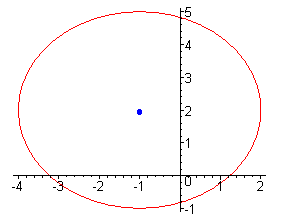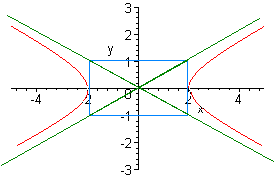Name
MATH 154 PRACTICE
MIDTERM III
Please work out each of the given
problems. Credit will be based on
the steps that you show towards the final answer.
Do all your work and give all your answers on you own sheet of paper.
Show your work.
Problem 1 (20 Points)
Sketch the graphs of the given functions:
A.
(10 Points)
x2
+ 4y2 = 1
9
Solution
First notice that this is an ellipse since both coefficients are positive. Putting the 4 in the denominator gives
x2
y2
+
= 1
9
1/4
So that
a = 3 b = 1/4
The vertices of the ellipse are at
(3,0), (-3,0), (0,1/4) (0,-1/4)
Now plot the points and sketch the ellipse.

B.
(10 Points) x2 + y2 + 2x - 4y
- 4 = 0
First complete the two squares
x2 + 2x + (1 - 1) + y2 - 4y + (4 - 4) - 4 = 0 Reordering and adding and subtracting b/2 to both
(x + 1)2 + (y - 2)2 = 9 Factoring, adding -1 - 4 - 4 = -9, and adding 9 to both sides
We recognize this as a circle with center (-1,2) and radius 3. The graph is given below

Problem
2
A. (8 Points) Find the first four terms of the sequence whose general term is given. Then find the 100th term.
an = n - 1/n
We have
a1 = 1 - 1/1 = 0
a2 = 2 - 1/2 = 3/2
a3 = 3 - 1/3 = 8/3
a4 = 4 - 1/4 = 15/4
a100 = 100 - 1/100 = 9999/100
B. (8 Points) Expand and simplify
![]()
We plug in 2, 3, 4, and 5 to get
[2(2) + 1] + [2(3) + 1] + [2(4) + 1] + [2(5) + 1]
= 5 + 7 + 9 + 11 = 32
C. (8 Points) Write the series in summation notation
1 2
3 4
+ +
+ + ...
2
3
4
5
The numerator is just n and the denominator is n + 1. Where n starts at 1 and continues to infinity. In summation notation, this becomes

Problem
3
A) (11 Points) Find the indicated unknown
8, 13, 18, 23, ..., 88 n = ?
Solution
This is an arithmetic sequence since
13 - 8 = 18 - 3 = 23 - 18 = 5
The common difference is d = 5.
The first term is 8, so the general formula is
an = 8 + 5(n - 1)
The last term is 88, so we set
88 = 8 + 5(n - 1)
80 = 5(n - 1) Subtract 8
16 = n - 1 divide by 5
n = 17 add 1
B) (11 Points) Find the sum of the given series
![]()
d = 3 a1 = 3 and n = 54
We use the sum of an arithmetic sequence formula to find the 54th term.
a54 = 3 + 3(54 - 1) = 162
The sum is
n/2 (a1 + an)
54/2 (3 + 162) = 4455
Problem
4
A. (11 Points) Find the indicated unknown
a1 = 5, a5 = 0.008 r = ?
This is a geometric sequence with
an = a1rn-1
We have
0.008 = 5r5-1
0.0016 = r4 Dividing by 5
r = ![]() (0.0016)1/4
=
(0.0016)1/4
= ![]() 0.2
0.2
B. (11 Points) A rubber ball is dropped on a hard surface and bounces to a height of 200 ft. On each rebound it bounces 95% as high as on the previous bounce. How high does the ball bounce on the 20th bounce?
We first write the first few terms of the sequence, which represents the height of the nth bounce.
a1 = 200 a2 = .95(200) a3 = .95(.95(200)) = .952(200)
We see that this is a geometric sequence with
an = 200(.95)n-1
We want the height of the 20th bounce. We have
a20 = 200(.95)19 = 75.5
The ball bounces about 75.5 feet on the 20th bounce
Problem
5
A. (11 Points) Find the sum of the infinite series if it exists.
1
1
1
1+
+ +
+ ...
3
9
27
This is a geometric sequence with first term 1 and common ratio r = 1/3. We have
a1
1
1
3
S
=
=
=
=
1 -
r
1 -
1/3
2/3 2
B. (11 Points) Write the repeating decimal as the ratio of two integers.
0.18
We write
0.18 = .18 + .0018 + .000018 + .00000018 +...
This is an infinite geometric sequence with
a1 = .18 = 18/100 and r = .01 = 1/100
We have
18/100
S =
1 - 1/100
18
=
Multiply top and bottom by
100
100 - 1
18
2
=
=
99
11
Problem
6 (20 Points)
Find the equation of conic with the graph shown below:

Since this is a hyperbola centered at the origin, we need to determine a, b, and the signs. Since the hyperbola has x intercepts, the coefficient in front of x is positive. We have
a = 2, b = 1
The equation is
x2
y2
-
= 1
4
1
or
x2 - 4y2 = 4